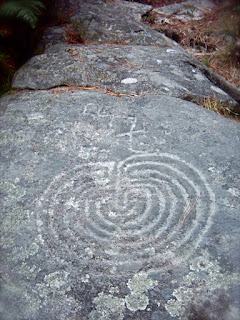The motif of the labyrinth has a long history. Depiction in rock art may date back as far as 10,500-4800 BC, and can be found across Europe, Africa, America and Asia. The labyrinth shares the same form, a unicursal meandering, turning and changing directions from outside to the center but never crossing itself.
The first ancient author to use the term ''labyrinth'' was the Greek historian Herodotus, in the 5th century BC. He referred to the Egyptian not Cretan labyrinth
Labyrinth in Greek mythology was an elaborate structure designed and built by the legendary artificer Daedalus for King Minos of Crete at Knossos. Its function was to capture the Minotaur, the mythical creature that was half man and half bull and eventually killed by Theseus. Daedalus had so cunningly made the Labyrinth that he could barely escape it after he built it.
Cretan Labyrinth image
Theseus in the Minotaur's labyrinth
Minotaur, with a body of a man and head of a bull
The Bronze Age site at Knossos was excavated by Arthur Evans in the early 20th century. Although early Cretan coins occasionally exhibit branching patterns, the single-path seven-course ''Classical'' design without branching or dead ends became associated with the Labyrinth on coins as early as 430 BC.
A seven-course ''Classical'' design on a CoinIn English, the term labyrinth is generally synonymous with Maze. Unicursal labyrinths appeared as designs on pottery or basketry or in etchings on walls or caved or churches.
Theseus and the Minotaur, ancient pottery
Pliny's (Gaius Plinius Secundus AD 23/24-79, called Pliny the Elder, was a Roman author) ''Natural History'', one of the largest works to have survived from the Roman Empire to the modern day, gives four examples of ancient labyrinths, the Cretan labyrinth, the Egyptian labyrinth, the Italian labyrinth and a Lemnian labyrinth.
A design identical to the seven-course pattern appeared in Native American culture, the Tohono Oódham people labyrinth which features Iitoi, the ''Man in the Maze'' although it has its entrance at the top.
In India, the ''Padmavyuha'' or ''Chakravyuha'' depict the labyrinth, and it is described in the ancient epic, ''Mahabharata''. The Chakravyuha was arranged by the Kauravas to fight the Pandavas in which Abhimanyu, the son of Arjuna was trapped and killed. Abhimanyupur, within the 48 kos parikrama of Kurukshetra in Haryana is identified as the site of the Chakravyuha. Examples have been found among cave art in northern India, on a dolmen shrine in the Nilgiri mountains and also as some plans of forts in India.
By the White Sea, notably on the Solovetsky Islands, there have been preserved more than 30 stone labyrinths, the most remarkable being the Stone labyrinths of Bolshoi Zayatsky Island.
Section of one of the largest stone labyrinths on Bolshoi Zayatsky Island
The other labyrinths found across the world are as shown
Labyrinth at Meis, Galicia, from the Atlantic Bronze Age
Crete, Knossos, Stater, 350-200 BC
Obverse: Female head right, in single pendant earring and necklace
Reverse: Labyrinth

























Another gem from your vast collection.Excellent research
ReplyDelete